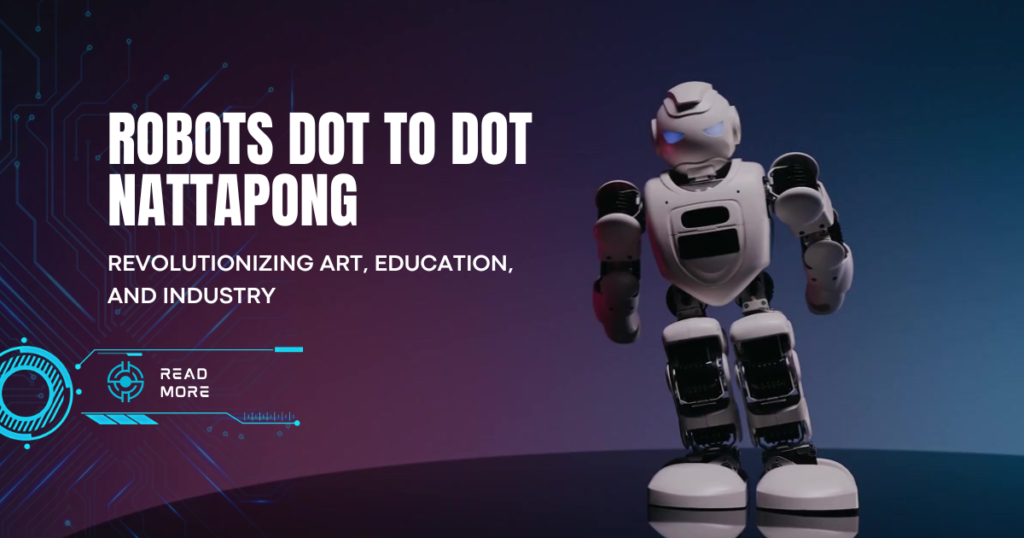In the rapidly evolving world of robotics and creativity, Robots Dot to Dot Nattapong stands out as a groundbreaking innovation that bridges art, technology, and education. Developed by visionary artist and technologist Nattapong, this concept has captured global attention for its ability to redefine traditional dot-to-dot puzzles through robotics. Whether enhancing artistic expression, improving STEM education, or transforming industries, Robots Dot to Dot Nattapong is a testament to the power of blending human creativity with machine precision.
What Is Robots Dot to Dot Nattapong?
At its core, Robots Dot to Dot Nattapong refers to an innovative system where robotic arms or devices connect dots on a canvas to create intricate patterns or perform tasks. Inspired by traditional dot-to-dot puzzles, this concept uses advanced algorithms and robotics to elevate the activity into an interactive and visually stimulating experience.
Key Features:
- Artistic Innovation: Robots create precise yet unpredictable designs by following pre-programmed paths.
- Educational Tool: Used in classrooms to teach robotics, programming, and problem-solving skills.
- Industrial Applications: Enhances accuracy in manufacturing, healthcare, agriculture, and logistics.
The Vision Behind Robots Dot to Dot Nattapong

Thai artist Nattapong envisioned this concept as a fusion of art and technology. His philosophy emphasizes that machines should enhance human creativity rather than replace it. Through his work, Nattapong demonstrates how robotics can add spontaneity and precision to artistic endeavors while inspiring learners and professionals alike.
Applications of Robots Dot to Dot Nattapong
1. Artistic Expression
Nattapong’s robotic systems create stunning artworks by connecting dots based on digital blueprints. This approach blends the organic essence of hand-drawn art with the precision of machine-generated designs. Artists can explore new dimensions by integrating algorithms into their creative processes.
2. STEM Education
Robots Dot to Dot Nattapong has become a popular tool in schools and workshops for teaching robotics and programming. Students program robots to connect dots in specific sequences, learning coding logic while engaging in hands-on activities. This method improves technological literacy and fosters interest in STEM careers.
3. Industrial Automation
Industries benefit from the efficiency of dot-to-dot robotics systems:
- Manufacturing: Robots streamline assembly lines by performing intricate tasks with high accuracy.
- Healthcare: Precision robots assist in surgeries and pharmaceutical production.
- Agriculture: Automated planting and harvesting reduce labor-intensive processes.
- Logistics: Robots optimize warehouse operations like inventory tracking and order fulfillment.
Success Stories & Case Studies

Case Study 1: Enhancing Math Skills
A middle school implemented Robots Dot to Dot Nattapong in geometry classes. Students programmed robots to create shapes like triangles and circles by connecting dots. This activity improved their understanding of geometric concepts while boosting engagement.
Case Study 2: Promoting Creativity in Art Classes
Elementary school students used robots to design intricate patterns during art lessons. The integration of technology fostered artistic exploration while teaching basic programming skills.
The Future of Robots Dot to Dot Nattapong

As technology advances, this concept is expected to evolve further:
- Integration with AI: Robots could adapt their designs based on user preferences or environmental factors.
- Augmented Reality (AR): AR overlays could enhance interactive learning experiences.
- Global Collaboration Platforms: Online communities could share puzzles and programs, fostering innovation worldwide.
FAQs
Q: What makes Robots Dot to Dot Nattapong unique?
Ans: Its fusion of art, technology, and education sets it apart, offering applications across creative industries, STEM learning, and automation.
Q: How can educators use this concept?
Ans: Teachers can incorporate dot-to-dot robotics into lessons on programming or geometry while encouraging teamwork through group projects.
Q: Are there industrial uses for this technology?
Ans: Yes! Industries like manufacturing, healthcare, agriculture, and logistics benefit from its precision and efficiency.
Q: Can individuals access this technology?
Ans: Dot-to-dot robotics kits are available for personal use, allowing hobbyists and learners to explore robotics at home.
Conclusion
Robots Dot to Dot Nattapong exemplifies how creativity and technology can coexist harmoniously. From inspiring artists to educating future innovators and revolutionizing industries, this concept continues to push boundaries across multiple domains. As we look ahead, its potential for growth remains limitless—making it a pivotal tool in shaping the future of art, education, and automation.
Read More: Wheonai.com Latest Trends | The Role of WheonAI Business | Izonemedia360 .com


